

 Vol. 40 (Number 31) Year 2019. Page 18
Vol. 40 (Number 31) Year 2019. Page 18
LOSHCHILOVA, Anna A. 1; DEMIDOVA, Natalya N. 2; VINOKUROVA, Natalya F. 3; ZULKHARNAYEVA, Anastasiya V. 4; MARTILOVA, Natalya V. 5 & SHEMANAYEV, Valeriy A. 6
Received: 03/06/2019 • Approved: 16/08/2019 • Published 16/09/2019
ABSTRACT: The purpose of the research was to substantiate theoretically and methodologically and to verify experimentally the effectiveness of environmental responsibility formation in schoolchildren aged 11-14 when they are involved in Green Teams school volunteer organizations aiming to study and develop local landscapes. A high educational and cultural ecological potential of a cultural landscape has been substantiated. The article content has a practical value for schoolteachers, extended education teachers, students of teaching profession, and supervisors of children’s associations. |
RESUMEN: El propósito de la investigación fue fundamentar teórica y metodológicamente y verificar experimentalmente la efectividad de la formación de responsabilidad ambiental en escolares de entre 11 y 14 años cuando participan en organizaciones voluntarias escolares de los Equipos Verdes con el objetivo de estudiar y desarrollar paisajes locales. El contenido del artículo tiene un valor práctico para maestros de escuela, maestros de educación extendida, estudiantes de profesión docente y supervisores de asociaciones de niños. |
Currently, human civilization is faced with global environmental, social, and economic problems, solving which would require consolidation of the entire world community and its common awareness and that of each individual of their responsibility for maintaining the environment (Mamedov et al., 2009; Ursul & Ursul, 2018).
Back in the early 20s of the 20th century, the outstanding Russian scientist and thinker Vernadsky, realizing a transforming human power, placed on humanity the responsibility not only for the fate of society but also for the biosphere as a whole.
The issue of responsibility for nature and for future generations was addressed as early as in the last century by (Müller, 2008) and it was later elaborated in the research of Atfield (1990), Naess and Sessins (2000). Thus, according to Jonas, responsibility is the core of a “new ethics of responsibility” of human civilization. Based on the categorical imperative “do so that your actions are in accord with the continuity of true human life on Earth”, it implies recognition of the moral rights of nature and prediction of consequences of one’s own actions in the environment.
Under these conditions, the education system should become an important factor in shaping personal attitudes of an individual to make responsible decisions in choice situations that would ensure harmonization of human relations with the environment. Performing a cognitive, evaluative, and regulatory function, environmental responsibility acts as a unity of emotional, rational, and volitional aspects.
During the study of philosophical, scientific, psychological, pedagogical, and methodological literature, a theoretical and methodological background to the research was identified. Works in environmental ethics (Callicott, 2018, Bamberg et al., 2018), the ideas of sustainable development co-evolution (Mamedov et al., 2009; Ursul & Ursul, 2018), eco-humanism and deep ecology (Naess & Sessins, 2000), environmental ideas in education (Yasvin, 2012; Mdivani et al., 2016), ideas of education in a team (Makarenko, 1978); the leading role of activity in personality formation (Feldstein, 2003), the locus of control concept (Rotter, 1966), a framework of forming environmental responsibility (Karopa, 1999), and technologies of collective creative activities (Ivanov, 1989).
A number of psychological and pedagogical studies (Aarnio-Linnanvuori, 2019; Zverev, 1983; Krasnova et al., 2017; Karopa, 1999; Suravegina, 2010; Bonnett, 2013; Palmer, 2002; Hungerford & Volk, 1990; Lieberman, 2013) point out that environmental responsibility as an integral quality of an individual is the result of a subjective refraction of an objective system of moral-ecological relations and requirements in the mind of the individual.
In the course of analyzing the works of Deryabo (2002), Yasvin (2012), Lerner (1978), Ovcharova (2014) and Rotter (1966), a number of diagnostic methods and tasks aimed at identifying the formedness of all the environmental responsibility components was identified.
To develop environmental responsibility effectively, Krasnova et al. (2017) stresses the need to use an interdisciplinary approach and to ensure interrelationship between class work and extracurricular activities, as well as inclusion of schoolchildren in socially useful activities to preserve and study the nature in their locality.
Karopa (1999), along with the interdisciplinary approach, notes the importance of applying elements of a systemic, cultural and historical approach, of modeling and historicism methods in the process of developing a responsible attitude to nature in schoolchildren.
Note that environmental responsibility is possible to form only with reference to the real world. The geographic studies of (Kalutskov & Krasovskaya, 2000; Gorbanyov & Kochurov, 2018; Krasovskaya & Trofimov, 2013; Stephenson, 2008; Woodgate & Isabwe, 2018) uphold the idea of “landscape” education.
A number of our studies (Vinokurova & Demidova, 2018; Vinokurova et al., 2018; Loshchilova et al., 2018) prove that a cultural landscape has a high educational potential in the field of environmental education.
Following Vedenin (2003), we consider the cultural landscape as a result of a harmonious and balanced interaction of human and nature whereby they come into contact with each other through a diversity of cultural and ecological activities.
From the above definition it can be seen that the cultural landscape is a human-controlled system, its harmony being determined by the anthropogenic factor associated with a responsible human attitude to the natural component.
These ideas have laid the groundwork for studying the cultural landscape as the basis for environmental responsibility formation in schoolchildren aged 11-14. The purpose of the research is to substantiate theoretically and methodologically and to verify experimentally the effectiveness of environmental responsibility formation in schoolchildren aged 11-14 when they are involved in Green Teams school volunteer organizations aiming to study and form the cultural landscapes in their locality.
The first study phase included stating an object, subject, goal and objectives of the research, as well as an operational hypothesis. The research problem in teaching theory and practice was analyzed. It has been determined that the structure of environmental responsibility includes motivational, cognitive, value-normative, and praxeological components (Suravegina, 2010), whereby the formedness of a given personal quality was assessed.
Along with such theoretical research methods as comparison, analysis and synthesis of literature on the problem, as well as modeling, empirical methods were used, a pedagogical experiment being the key method among them.
Secondary general schools of the city of Dzerzhinsk (municipal budgetary general education institution (MBGEI) “School No.32”) and the city of Nizhny Novgorod (MBGEI “School No.35”) became an experimental base of the research. 130 members of volunteer school organizations aged 11 to 14 took part in the pedagogical experiment.
The authors’ team selected and adapted assessment methods that allowed them to check and evaluate the formedness of all the environmental responsibility components.
The motivational component of environmental responsibility is assessed upon the criterion of environmental motives. Based on the research of Ovcharova (2014), the following levels of their development have been identified:
- extrinsic negative ecological motives,
- extrinsic positive ecological motives,
- intrinsic socially significant environmental motives
- intrinsic individually significant environmental motives.
The cognitive component reflects the formedness of ethical and cultural-environmental awareness of the local cultural landscape and is assessed upon the criteria of depth, generality, and consciousness (Lerner, 1978). The depth of knowledge is expressed at the level of facts and understanding significant features of a concept. Generality is characterized by understanding of the essence of the problem under study and knowledge systematization. Consciousness is seen as an opportunity to independently apply knowledge in various standard and non-standard situations.
Dominance has become a criterion for assessing the value-normative component of environmental responsibility (Yasvin, 2012), which describes a subjective, value-based attitude to nature along the “insignificant–significant” axis to nature. There are three levels of dominance: high, medium, and low.
The formedness of the praxeological component is determined by assessing the levels of voluntary performance of environmentally responsible activities aimed at developing local landscapes: low, medium and high (Matyukhina & Spiridonov, 2011).
The formedness of subjective control of an individual is tested upon the criterion “internality-externality” reflecting two kinds of subjective control (Visdómine & Luciano, 2006), whereby internality is associated with an individual acknowledging themselves as the cause of change and assuming responsibility for the consequences of their actions, while externality suggests evading the responsibility.
Based on the proposed methods, we performed an assessment of the initial level of environmental responsibility indicators, which allowed us to determine initial data for further pedagogical research.
In the second (main) phase of the study, the accumulated theoretical and empirical material was systematized and a methodology for environmental responsibility formation in the study and development of cultural landscapes was developed. Methodological conditions for environmental responsibility formation in students were identified. The developed technique was implemented in practice.
In the third phase, the results of the pedagogical experiment were summarized and prospects for further development of the problem were specified.
Based on the scientific literature analysis, methodological conditions were determined that would ensure environmental responsibility formation in schoolchildren when studying cultural landscapes.
The study has shown that to form environmental responsibility in schoolchildren, it is necessary to: 1) consider the cultural landscape from the perspective of a real-life cultural ecological educational environment; 2) develop and implement a system of ecologically responsible activities in the cultural landscape within school volunteer organizations.
Let us dwell upon them in more detail.
Cultural ecological educational environment is one of the most important conditions for environmental responsibility formation in schoolchildren. This concept had been introduced by the authors of the article in previous studies (Zulkharnaeva et al., 2017; Vinokurova & Demidova, 2018).
In this research, the infrastructure of cultural ecological educational environment, along with pedagogically defined educational facilities and conditions, expands by means of a real-world socio-natural space, which is the cultural landscape.
The cultural landscape is considered by the authors as a natural socio-cultural environment in various spheres of schoolchildren’s activities, a “real-life teaching aid” that promotes “growing” of an individual into an ecological situation, which inclines them towards studying, evaluating, and performing creative practical activities.
Based on the analysis of psychological studies (Mdivani et al., 2016), structural components of the reported environment were identified: a spatial-objective component, a communicative component, and a technological component.
The spatial-objective component is a cultural landscape as a real-world educational space that is not only a material but also a spiritual human life support system. Consequently, the cultural landscape, in this context, has an educational and aesthetic impact on a student, contributes to the formation of ethical behavioral norms in the immediate environment. The cultural landscape arouses cognitive interest in schoolchildren to the surrounding natural and social objects.
It is important to study cultural landscapes of different levels. Microlevel includes nature study corners at school and school grounds. Mesolevel comprises objects of the locality, such as parks, forest parks, water bodies, cultural and natural heritage resources, etc. Macro level covers cultural landscapes of the country and the world.
Studying diverse landscape environment ensures students’ awareness of their subjective needs and contributes to the development of ways of life in the environment. At the same time, landscapes are peculiar features of environmental problems and become real-world objects of not only research but also of cultural transformation. Landscaping activities contribute to determining the role and significance of schoolchildren in solving the environmental problems in their locality and the world as a whole, which is important in the course of environmental responsibility formation.
The communicative component of cultural ecological educational environment is implemented through the form of organizing work with schoolchildren. Green Team school volunteer organization is such a form that ensures environmental responsibility formation in terms of responsible activities in the real-life cultural landscape. Schoolchildren are involved in various types of communication in the process of developing and cultural transformation of the landscape: communication, identification, reflection, value rethinking, and individual moral self-regulation.
Such interaction is based on the ideas of a dialogue interaction between an individual and the environment. A dialogue in this context performs a number of functions: informational-communicative (receiving and transmitting information), regulatory-communicative (possibility of regulating other people and “adjusting” to their influence), and affecting-communicative (changing the emotional state of interacting subjects). The dialogue type of relationship involves students not only in interpersonal communication within the Green Team school volunteer organization but also provides for interaction with natural and cultural landscape objects at the level of cooperation, collaboration, co-creation, thereby recognizing the uniqueness and value of the cultural landscape components.
The communicative component of the environment is also implemented through cooperation with environmental entities and organizations of different territorial levels in social media.
The technological component involves the use of pedagogical technologies for forming environmental responsibility in students. We have developed a technology for organizing eco-responsible activities. It has been established that it will contribute to the waking of environmental emotions in schoolchildren, engaging environmentally oriented development values, and taking environmentally responsible decisions.
The second methodical condition is a system of environmentally responsible activities and its implementation within the framework of school volunteer organizations. This system ensures the involvement of schoolchildren in cognitive, communicative, and practical activities on studying and developing the cultural landscape as a logically completed methodological constructor.
When working as a team while carrying out environmentally responsible activities, students are included in the cooperation relations, co-creative development of the world; they acquire the ability to make collective decisions and take responsibility. Such interaction contributes to self-organization of students in terms of environmental responsibility development.
The implementation of responsible activities involves working in temporary self-organizing small affinity groups. The developed system includes five types of responsible activities identified in accordance with the structure and sequence of environmental responsibility formation: 1) motivational stimulating, 2) environmental awareness building, 3) axiological, 4) practical creative, 5) reflexive evaluative.
The technology for organizing ecologically responsible activities includes several stages: 1. “Choice”; 2. “Creative Pursuit”; 3. “Development of an Activity and Distribution of Actin Points”; 4. “Implementation”; 5. “Reflection”.
Based on the technology of responsible activities, its participants acquire and improve the skills of identifying, selecting and solving environmental problems of landscapes of various levels and productive landscaping activities in a team.
Let us give specific examples of the types of responsible activities that we have identified.
- Motivational stimulating environmentally responsible activities aimed at studying the cultural landscape, among them: the online operation “Ecological Search” on the following topics: “Environmental responsibility in maxims and quotations”; “Experience of ecologically responsible behavior in a cultural landscape”; “My environmental responsibility and cultural landscape”; Operation “Ecological Video” on the topic “The image of an ecologically responsible citizen”; a relay story; Operation “Environmental Quiz In the World of Cultural Landscapes ”; Operation “I am a Researcher of the Cultural Landscape”; cognitive travel “Natural and Cultural Heritage and Environmental Responsibility”, etc.; Operation “The Mindmap of the Cultural Landscape”; a tournament of experts, etc.
- Environmental awareness building responsible activities: Operation “Leaflet”; online operation “We are Sociologists: Attitude to the Cultural Landscape”; Operation “Eco-Tale”; Operation “Exhibition”; Operation “About Nature for Kids”; Operation “About Environmental Responsibility in Social Media”; virtual tours, etc.
- Axiological eco-responsible activities contributing to the development of environmental feelings and experiences, their connection to the cultural landscape, the responsibility for its conservation, and ethical practices in attitudes towards nature. The totality of these responsible activities contributes to the experience of personal responsibility for ensuring sustainable development of the cultural landscapes of the locality. Some examples of axiological environmentally responsible activities are: Operation “Comprehension” on the topics: “Behests of the Little Prince”, “The narratives of environmentally responsible attitude to nature”; Operation “Immersion”–“Feel it with your heart”; Relay “Let’s Draw Up Together” on the topic “The Ecologically Responsible Person’s Code”; Operation “Our Responsibility Map”, etc.
- Practical creative eco-responsible activities involve creative landscaping work in the course of practical activity office operation named “Care”. For example: Operation “Ecological Campaign: Act Responsibly”; ecological online campaigns promoting a responsible attitude to cultural landscapes; Operation “Ecological Design in the Cultural Landscape”. As a result, schoolchildren have the opportunity to have their need for a personalized space met and, therefore, be responsible for its preservation.
- Reflexive evaluative ecologically responsible activities: panel discussion “The Results of Our Landscaping Work” “Our Environmentally Responsible Steps to the Future”; “Relay of Achievements in the Landscapes of My Locality”, “Our Contribution to the Preservation of Nature”; Operation “Assessment and Forecast” and “Environmental Responsibility–a Retrospective inside Yourself”.
The pedagogical experiment involved 130 schoolchildren aged 11 to 14. During the experiment, control and experimental groups were isolated. The control group participants were not subjected to experimental influence and were used to meet the pedagogical experiment reliability standard, as well as to compare the results obtained.
An assessment made at the ascertaining and control stages of the experiment revealed the dynamics of development of all the environmental responsibility components in the students.
The results of assessing the motivational component (Figure 1) at the ascertaining experimental stage indicate predominance of extrinsic positive and extrinsic negative environmental motives in students. The schoolchildren showed readiness for environmentally responsible activities subject to an approval of the team and praise from the teacher. They are characterized by external compliance with environmental norms and requirements. After the second experimental stage, a positive development trend of the environmental motives in the experimental group participants was established. The indicators of intrinsic socially significant (from 19% to 29%) and intrinsic individually significant (from 14% to 33%) environmental motives have doubled, which gives evidence of a developed internal need for environmentally responsible behavior. In the control classes, a marginal dynamics in the development of these types of motives was observed.
Figure 1
Assessment Results of the Motivational
Component of Environmental Responsibility
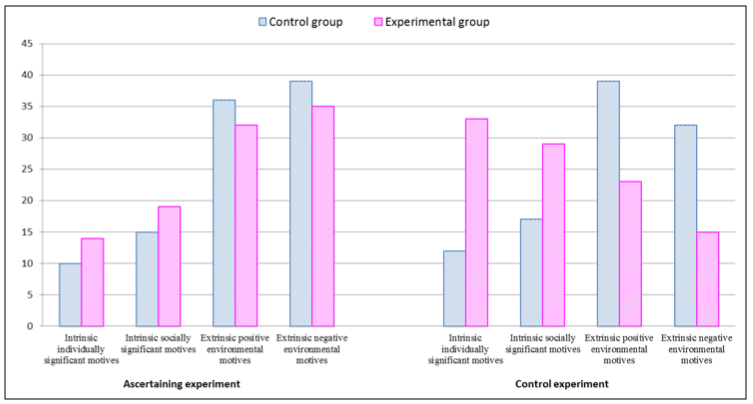
Source: Compiled by the authors
Analysis of the formedness of the cognitive component of environmental responsibility has allowed us to establish the degree of scientific content assimilation (depth, generality, and consciousness of cultural landscape knowledge). At the end of the second stage, 58% of the participants in the experimental group demonstrated a depth of environmental knowledge at the level of identifying essential features (Figure 2), which is twice as high as at the ascertaining experimental stage. Note that in the control group there is also a tendency to a greater depth of environmental knowledge. Most likely, it is associated with the students studying science subjects containing an environmental component.
Figure 2
Assessment Results of the Cognitive
Component of Environmental Responsibility
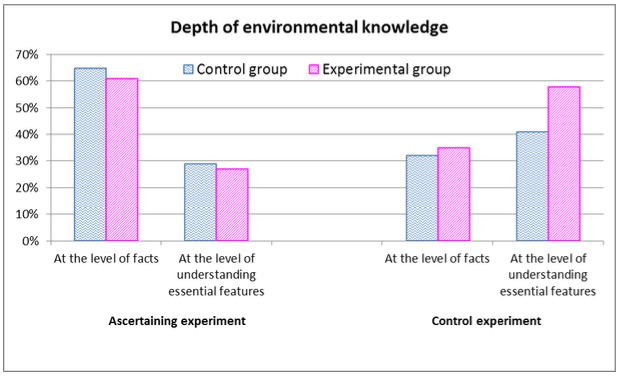
Source: Compiled by the authors
In contrast to the control group, there are also twice as many students in the experimental group who have shown the generality level of environmental knowledge about the cultural landscape at the level of explanation of cause-effect relationships–64% against 35% (Figure 3), which indicates a fairly high level of systematization and understanding of scientific content.
Figure 3
Assessment Results of the Cognitive Component
of Environmental Responsibility
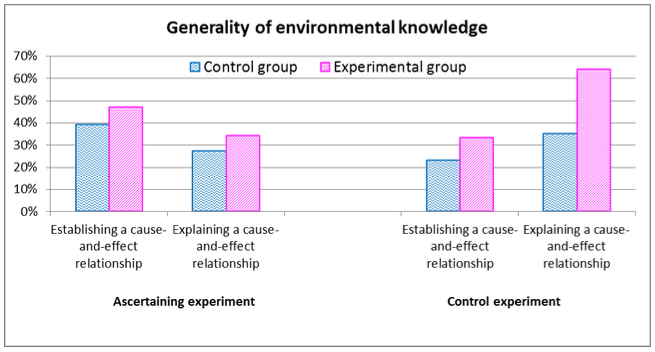
Source: Compiled by the authors
During the control experimental stage, a significant increase in the consciousness of environmental knowledge in the experimental group (63%) compared with the control group (35%) was identified.
Comparing the results of the ascertaining and control stages of the experiment in the experimental group has revealed a similar trend: the consciousness of environmental knowledge at the knowledge application level in an unknown situation has increased from 41% to 63% (Figure 4).
Figure 4
Assessment Results of the Cognitive
Component of Environmental Responsibility

Source: Compiled by the authors
Assessment of the value-normative component upon the dominance criterion (Figure 5) at the control experimental stage made it possible to establish prevalence of medium and high levels of dominance in the experimental group participants. The schoolchildren were offered to choose three most important and least important concepts from a list and then rank them by personal significance. 43% of schoolchildren in the experimental group named nature among the three most significant concepts, which indicates a high level of dominance of a responsible attitude to the environment and a positive trend of awareness of the value of nature. For reference, at the ascertaining experimental stage only 23% of students mentioned the value of nature among the top three priorities.
Figure 5
Assessment Results of the Value-Normative
Component of Environmental Responsibility

Source: Compiled by the authors
During the control experimental stage, it was found that 68% of the participants in the experimental group had a high level of voluntary performance of the assigned environmental tasks, which is almost three times as high as in the control group (25%). For reference, the ascertaining stage was characterized by its high level in only 21% of the control group students and 18% of the experimental group students (Figure 6).
Figure 6
Assessment Results of the Praxeological
Component of Environmental Responsibility
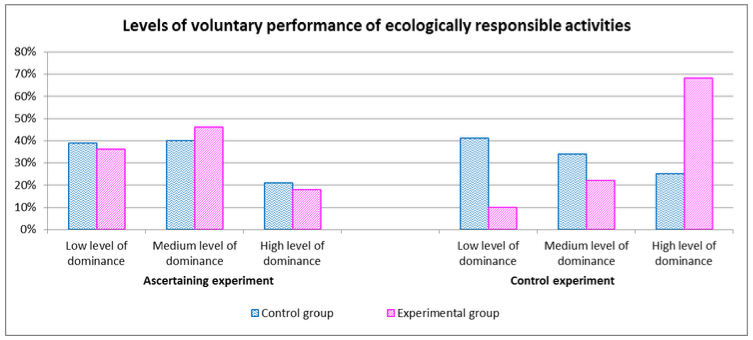
Source: Compiled by the authors
Also, to determine the prevailing type of subjective control, that is, internality (internal control) and externality (external control), the schoolchildren were asked to perform test assignments, analysis of which has shown that more than half of the experimental group participants have an internal nature of environmental responsibility (64%), which testifies to awareness of their personal responsibility for the socio-natural environment conservation. The external locus of control is inherent in the control group to a greater extent (Figure 7).
Figure 7
Assessment Results of the Praxeological
Component of Environmental Responsibility
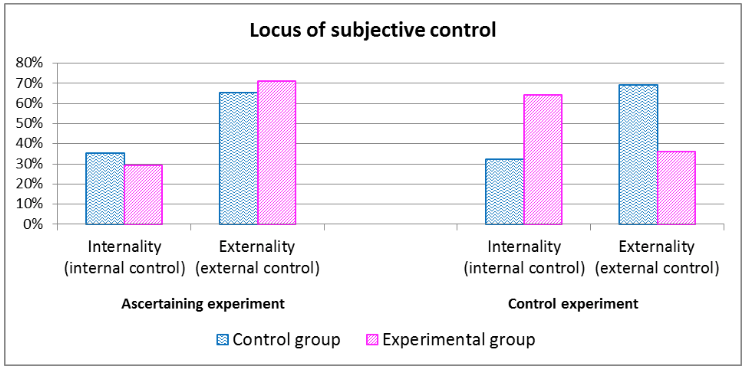
Source: Compiled by the authors
Thus, the data obtained during the experiment indicate a fairly high level of formedness of all the environmental responsibility components in the experimental group students.
Analysis of theoretical research has allowed us to identify the role of cultural landscape in environmental responsibility formation in schoolchildren within the framework of school volunteer organizations. Our study views the cultural landscape as a real-life cultural ecological educational environment. This environment allows for “soft control” of the process of environmental responsibility development in schoolchildren by immersing them in real-world cognitive, value-based and practical development of the cultural landscape of their locality. Structural components of this environment have been identified; they are represented by spatial-objective, communicative, and technological components.
A technology for organizing environmentally responsible activities has been developed. It has been experimentally verified that the system of ecologically responsible activities implemented in a school volunteer organization contributes to purposeful inclusion of students in collective creative exploration and development of the cultural landscape.
The identified conditions ensure consistent formation of all the structural elements of environmental responsibility, which is confirmed by the outcome of the pedagogical experiment.
The research was sponsored by an RFBR grant, project 19-013-00749, Competition code A “Study of theoretical foundations of developing environmentally oriented vital activity in schoolchildren in a cultural landscape”.
Aarnio-Linnanvuori, E. (2019). How do teachers perceive environmental responsibility? Environmental Education Research, 25(1), 46-61.
Atfield, R. (1990). Ethics of Environmental Responsibility. Moscow: Progress.
Bamberg, S., Rees, J., and Schulte, M. (2018). Environmental protection through societal change: What psychology knows about collective climate action—and what it needs to find out. In S. Clayton, and Ch. Manning (eds.), Psychology and Climate Change (pp. 185-213). Academic Press.
Bonnett, M. (2013). Moral Education and Environmental Concern. New York: Routledge.
Callicott, J. B. (2018). Environmental ethics. Encyclopedia of the Anthropocene, 4, 1-10.
Deryabo, S. V. (2002). The phenomenon of subject perception of natural objects. Psychology Issues, 1.
Feldstein, D. I. (2003). Priority directions of development of psychological research in the field of education and self-education of modern man. Psychology Issues, 6.
Gorbanyov, V. A., and Kochurov, B. I. (2018). The problem of territorial zoning of the Russian Federation: Domestic and international aspects. MGIMO Review of International Relations, 61(4), 23-54.
Hungerford, H. R., and Volk, T. L. (1990). Changing learner behavior through environmental education. Journal of Environmental Education, 21, 8-21.
Ivanov, I. P. (1989). Encyclopedia of Collective Creative Affairs. Moscow: Pedagogy.
Kalutskov, V. N., and Krasovskaya, T. M. (2000). Conceptions of cultural landscape: From professional to philosophic. Moscow University Bulletin, Series 5 Geography,4, 3-6.
Karopa, G. N. (1999). System differentiation principle in ecological education. Psychology Issues, 2, 28-34.
Krasnova, L. A., Mamchenko, A. A., and Zakhlebniy, A. N. (2017). International conference education environment for the information age. European Proceedings of Social and Behavioural Sciences, 28, 388-396.
Krasovskaya, T. M., and Trofimov, A. B. (2013). Postnonclassical geography in Russia. Geography and Natural Resources, 34(4), 303-307.
Lerner, I. Ya. (1978). The Quality of Student Knowledge. What It Should Look Like? Moscow: Knowledge.
Lieberman, G. A. (2013). Education and the Environment; Creating Standards-Based Programs in Schools and Districts. Cambridge: Harvard Education Press.
Loshchilova, A. A., Vinokurova, N. F., Zulkharnaeva, A. V., Nikolina, V. V., Krivdina, I. Yu., and Martilova, N. V. (2018). The evelopment of environmental responsibility among students in the 5th - 7th grades by means of eco-humanistic-oriented educational environment of the children’s geo-eco club. International Journal of Civil Engineering and Technology,9(11), 1975-1990.
Makarenko, А. S. (1978). Selected pedagogical works: in 2 volumes. Moscow: Pedagogy.
Mamedov, N. M., Gay, W. C., and Chumakov, A. N. (2009). Encyclopedia of Environmental Ethics and Philosophy. Volume 2. Detroit, New York: CENGAGE Learning.
Matyukhina, M. V., and Spiridonov, S. B. (2011). Self-Knowledge and Its Formation in Primary School Age. Study Guide. Volgograd: Volgograd State Pedagogical University.
Mdivani, M. O., Panov, V. I., and Cherezova, L. B. (2016). Empirical study of environmental awareness in children of preschool and primary school age (6–10 years old). Experimental Psychology, 9(4), 48-58.
Müller, W. E. (2008). Hans Jonas: Philosoph der Verantwortung. Darmstadt: Primus.
Naess, A., and Sessins, J. (2000). Deep ecology platform. Humanitarian Environmental Journal, 2(1), 56-57.
Ovcharova, R. V. (2014). Typological characteristics of the border service, as subjects of the perception of the person's appearance. In European Conference on Education and Applied Psychology, 1st International Scientific Conference (pp. 101-106). Vienna, Austria: «East West» Association for Advanced Studies and Higher Education GmbH.
Palmer, J. (2002). Environmental Education in the 21st Century: Theory, Practice, Progress and Promise. London: Routledge.
Rotter, J. В. (1966). Generalized expectancies for internal versus external control of reinforcement. Psychological Monographs, 80,1‑28.
Stephenson, J. (2008). The cultural values model: An integrated approach to values in landscapes. Landscape and Urban Planning, 84(2), 127-139.
Suravegina, I. T. (2010). Who is man, or the mystery of a human being. Biology at School, 2, 39-43.
Ursul, A. D., and Ursul, T. A. (2018). Universal (global) evolutionism. The Journal Philosophy and Cosmology, 20, 31-41.
Vedenin, Yu. A. (2003). Informational base of investigating and forming of the cultural landscape as the heritage object. Proceedings of the Russian Academy of Sciences, Geography Series, 3, 7-13.
Vinokurova, N. F., and Demidova, N. N. (2018). Environmental Education and Awareness of Schoolchildren in the Nizhny Novgorod Region: Software and Technological Support. Nizhny Novgorod: Povolzhie.
Vinokurova, N. F., Zulkharnaeva, A. V., Krivdina, I. Y., Martilova, N. V., Badin, M. M., and Shemanayev, V. A. (2018). Formation of ecological values of sustainable development in upper secondary school students in geography training. Espacios, 39(30), 15.
Visdómine, J. C., and Luciano, C. (2006). Locus of control and behavioral self-regulation. Conceptual and experimental reviews. International Journal of Clinical and Health Psychology, 6(3), 729-751.
Woodgate, D., and Isabwe, G. M. N. (2018). Developing future vision landscape and models of technology enhanced learning. In 12th International Technology, Education and Development Conference (pp. 6824-6835). Valencia, Spain: IATED.
Yasvin, V. A. (2012). Development of regional standard of general education social quality concept. European Journal of Contemporary Education, 1(1), 82-92.
Zulkharnaeva, A. V., Vinokurova, N. F., KrivdinaI, Y., Martilova, N. V, and Badin, M. M. (2017). Training of a geography teacher in the process of getting master's degree to form the experience of making decisions on environmental problems by students of 10 grades: Theory and methodological experience. Man in India, 97(15), 559-571.
Zverev, I. D. (1983). Formation of a responsible attitude to nature. Pedagogy, 12, 12-19.
1. Department of General and Social Pedagogy. Kozma Minin Nizhny Novgorod State Pedagogical University, Russia
2. Department of Ecological Education and Environmental Management. Kozma Minin Nizhny Novgorod State Pedagogical University, Russia
3. Department of Geography, Geographical and Geoenvironmental Education. Kozma Minin Nizhny Novgorod State Pedagogical University, Russia
4. Department of Geography, Geographical and Geoenvironmental Education. Kozma Minin Nizhny Novgorod State Pedagogical University, Russia. anastasia.zulkharnaeva@yandex.ru
5. Department of Geography, Geographical and Geoenvironmental Education. Kozma Minin Nizhny Novgorod State Pedagogical University, Russia
6. Department of Biology, Geography and Chemistry. Lobachevsky State University of Nizhny Novgorod–National Research University, Arzamas branch, Nizhny Novgorod, Russia